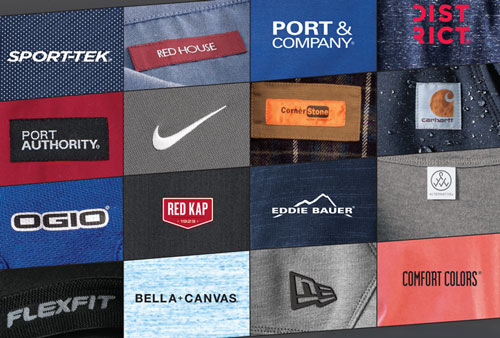How to Identify High-Quality Fabrics in Branded Clothing
How to Identify High-Quality Fabrics in Branded Clothing
Blog Article
The Value of Sustainable Garments: How It Affects the Setting and Your Closet
Sustainable apparel is progressively identified for its crucial function in decreasing the environmental effect of the rapid style industry. By concentrating on environmentally friendly products and moral manufacturing methods, it attends to pushing ecological issues. This shift not only profits the world however also affects customer choices, bring about a more thoughtful strategy to closet administration. Recognizing these characteristics elevates important inquiries regarding style's future and individual duty fit it.
The Ecological Footprint of Quick Style

Advantages of Lasting Products
Lasting products use considerable advantages, particularly through green textile selections that lessen environmental harm. These materials additionally show sturdiness and longevity, reducing the demand for constant replacements. As a result, they contribute to a much more lasting fashion business and advertise accountable consumer behavior.
Eco-Friendly Material Choices
While the fashion sector has long been connected with fast trends and environmental damage, the rise of environment-friendly fabric selections provides a transformative opportunity. Lasting materials such as natural cotton, hemp, and Tencel have actually gained popularity because of their reduced environmental impact. These textiles are often created without hazardous chemicals and require much less water, minimizing their carbon footprint - Branded Clothing. In addition, numerous environmentally friendly textiles are biodegradable, adding to a round economic climate by minimizing waste. Selecting lasting products not only supports environmentally accountable techniques but likewise advertises much healthier communities. As consumers become much more knowledgeable about their buying power, the demand for eco-friendly fabrics motivates brands to introduce and take on even more lasting manufacturing techniques, inevitably profiting the world and future generations
Durability and Long Life Advantages
Many consumers are increasingly acknowledging the durability and longevity benefits of sustainable materials in their clothes options. Unlike conventional materials, lasting materials such as organic cotton, hemp, and recycled polyester are engineered to stand up to deterioration, leading to garments that last longer. This lowered regularity of substitute not only conserves customers cash with time but also diminishes waste generated by rapid style. In enhancement, lasting apparel frequently employs environment-friendly manufacturing techniques that boost textile toughness, adding to a decrease in the total carbon impact. By spending in long lasting apparel, customers can grow a more lasting closet while appreciating top quality pieces that maintain their visual and capability over time. Consequently, sturdiness and durability stand as key advantages of choosing lasting materials.
Lowering Waste With Sustainable Practices
Reducing waste in the garment industry can be accomplished through cutting-edge methods such as upcycling and repurposing products. In addition, embracing minimal wardrobe methods encourages consumers to focus on top quality over amount, eventually decreasing apparel consumption. Together, these methods contribute substantially to an extra lasting garments design.
Upcycling and Repurposing Materials
Upcycling and repurposing materials have emerged as cutting-edge approaches in the garment industry, transforming disposed of textiles right into beneficial new items. This technique not only decreases waste but likewise urges creative thinking and individuality in clothes style. By taking old garments and products, designers can create distinct pieces that show personal style while lowering the need for brand-new sources. In addition, upcycling typically requires less energy and water contrasted to standard manufacturing procedures, significantly reducing the environmental footprint of fashion. As consumers become a lot more mindful of sustainability, the appeal of upcycled garments proceeds to rise, promoting a circular economic situation. Eventually, these methods add to an extra lasting future, where style prioritizes environmental health and wellness over quick production and consumption.

Minimal Closet Methods
As people increasingly look for to reduce their ecological influence, adopting minimalist closet approaches has gotten grip as an effective technique to lasting style. These strategies emphasize quality over amount, motivating customers to curate a smaller collection of functional, sturdy garments. By focusing on timeless items that can be combined and matched, individuals can lower the regularity of acquisitions and eventually reduce waste.Additionally, minimalism promotes mindful intake, prompting buyers to review the environmental and ethical ramifications of their options. This strategy not just cultivates a more sustainable lifestyle yet also simplifies daily decision-making relating to clothes. As individuals accept minimal principles, they add to a fashion culture that values sustainability and liable consumerism, eventually bring about a more eco-conscious society.
The Role of Ethical Labor in Sustainable Style
While several customers are significantly knowledgeable about the ecological consequences of their clothes options, the importance of ethical labor techniques in lasting fashion can not be overlooked. Ethical labor incorporates reasonable earnings, risk-free working conditions, and respect for employees' legal rights, creating the foundation of accountable style manufacturing. Brands that prioritize honest labor not just uplift communities however also established a standard for accountability in the industry.Moreover, the assimilation of honest practices cultivates openness, allowing customers to make educated options regarding their acquisitions. This method contrasts greatly with rapid fashion's unscrupulous labor designs, which commonly prioritize earnings over people. By sustaining companies devoted to honest labor, customers contribute to a system that values human self-respect alongside ecological sustainability. Ethical labor is not just an add-on; it is crucial to the more comprehensive mission of sustainable fashion, making certain that the quest for eco-friendliness does not come at the cost of human rights.
The Influence of Lasting Apparel on Carbon Emissions
Sustainable apparel has the potential to substantially reduce carbon discharges associated with the garment industry. Typical garment manufacturing adds significantly to greenhouse gas discharges, mainly because of energy-intensive manufacturing processes and using non-renewable sources. In comparison, lasting fashion concentrates on environment-friendly materials, such as natural cotton or recycled fibers, which often require much less energy to produce.Moreover, websites sustainable brands tend to take on a lot more effective manufacturing techniques, reducing waste and lowering total emissions. By focusing on durability and classic design, lasting garments encourages customers to acquire much less regularly, more decreasing the carbon impact connected with overconsumption.Additionally, numerous lasting brand names are committed to openness in their supply chains, enabling consumers to make enlightened options that straighten with their worths. Ultimately, moving towards lasting garments can bring about a substantial reduction in carbon discharges, contributing to a much healthier planet and a much more sustainable future for the fashion business.
Supporting Regional Economies With Lasting Choices
The shift towards sustainable clothes not just addresses environmental concerns but additionally significantly advantages neighborhood economic climates. By picking lasting fashion, consumers usually sustain small businesses and local artisans, improving neighborhood article source durability. These ventures typically operate on a smaller scale, prioritizing craftsmanship and ethical methods over mass production.Investing in locally made sustainable garments promotes task development and stimulates financial development within areas. As customers end up being much more knowledgeable about the environmental impact of their acquisitions, they increasingly seek items that mirror their values. This demand motivates neighborhood manufacturers to take on sustainable techniques, adding to a round economy.Moreover, supporting neighborhood companies minimizes transportation emissions, aligning with eco-conscious consumer behavior. The interconnectedness of lasting apparel and regional economic climates highlights the vital role that individual choices play in promoting both economic and ecological health and wellness. By fostering these neighborhood connections, communities can thrive while additionally working towards an extra sustainable future.
Transforming Your Closet: Tips for a Lasting Wardrobe
As individuals seek to decrease their ecological impact, changing a wardrobe into a lasting closet ends up being a necessary action. One effective approach is to assess existing clothing, keeping only items that are worn frequently which align with sustainability objectives. Focusing on quality over amount is vital; purchasing durable items from environment-friendly brands can considerably lower waste.Additionally, including second-hand things can breathe brand-new life right into a closet while reducing ecological damages. Organizing clothes swaps with friends or giving away unused products can additionally promote sustainability.When shopping, individuals ought to seek products that are natural, recycled, or naturally degradable, and avoid rapid style sellers - Branded Clothing. Practicing mindful intake by attentively thinking about each purchase can contribute to a much more lasting way of living. By carrying out these tips, one can create a wardrobe that shows individual design while sustaining environmental stewardship
Frequently Asked Concerns
How Can I Identify Lasting Apparel Brands?
To identify lasting garments brands, one ought to investigate materials utilized, look for certifications like Fair Profession, and examine the brand name's transparency regarding official website their production procedures, labor techniques, and environmental impact, guaranteeing ethical and environment-friendly practices are prioritized.
What Are the Prices Connected With Sustainable Fashion?
The prices connected with lasting style can differ substantially. Higher manufacturing expenses, moral sourcing, and environment-friendly materials frequently lead to boosted list prices, which might discourage some customers while attracting environmentally aware consumers.
Can Sustainable Apparel Be Elegant and Trendy?
Lasting garments can certainly be fashionable and trendy. Designers significantly prioritize ingenious materials and moral production techniques, proving that fashion and sustainability can exist side-by-side. Customers now have varied alternatives that blend looks with environmental consciousness.
Exactly How Does Laundering Clothes Affect Their Sustainability?
Cleaning garments greatly effects sustainability by consuming water and energy, adding to pollution, and triggering microplastic launch. Frequent cleaning can weaken textiles, shortening their life expectancy and increasing the requirement for substitutes, eventually intensifying environmental issues.
What Is the Life Expectancy of Sustainable Apparel Compared to Fast Fashion?
The lifespan of sustainable clothing usually goes beyond that of rapid style products, frequently long-term a number of years as a result of quality products and craftsmanship. On the other hand, quick style garments might deteriorate rapidly, necessitating even more regular substitutes. Lasting apparel is increasingly identified for its crucial function in reducing the environmental influence of the quick style market. While numerous customers are significantly conscious of the ecological effects of their garments options, the significance of ethical labor techniques in sustainable fashion can not be forgotten. Branded Clothing. Lasting clothes has the possible to considerably reduce carbon exhausts linked with the fashion market. In comparison, lasting fashion focuses on environmentally friendly products, such as natural cotton or recycled fibers, which usually need much less energy to produce.Moreover, lasting brands often tend to take on a lot more efficient production practices, reducing waste and decreasing overall exhausts. By prioritizing durability and classic layout, lasting clothing motivates customers to get much less frequently, more decreasing the carbon impact connected with overconsumption.Additionally, many lasting brand names are committed to transparency in their supply chains, enabling consumers to make enlightened choices that straighten with their values
Report this page